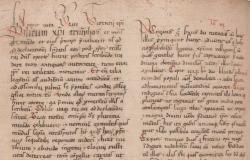For convenience it is best to start from the end, if it can be defined as an end. A part of Pozzuoli believes (but perhaps, given the way he expresses it, it would be better to use “is convinced”) that the current bradyseism is somehow linked to the moving of the statue of Santo Mamozio from the headquarters in Piazza della Repubblica to the one in Piazza Cesare Augusto (which is not really far away). But – like everything that touches the sacred and the mystery – things are much more complex. And so we need to go back a few centuries. It is 1631 and the new bishop arrives in Pozzuoli, Spanish as befits the times: Martin de León y Càrdenas.
The prelate had to be a man of action and also (and above all) of power: he had been appointed bishop only a year before Trivento which, with all due respect for its imposing history dating back to the third century, did not have the stage offered by Pozzuoli. A stage that the bishop honored as best he could: first of all, as was appropriate at the time, he immediately gave prestige to the Cathedral in the Terra district, adapting it to the style of the time: the Baroque. In the naves he summoned and obtained the work of the best painters of the Neapolitan school with three works by Artemisia Gentileschi. Then he launched an ambitious program of public works with an eye on the conditions of the less wealthy classes. For so much attention to the community – something that was not at all common among the prelates of the time, more dedicated to taking than giving – the people of Puteola immediately thanked him by sending back to Naples, in 1647, as many as six thousand followers of Masaniello who, having arrived at the gates of Pozzuoli, they intended to plunder first of all the ecclesiastical properties (and therefore the bishop) and then, finding themselves, all the rest of the city. They returned to the capital empty-handed and with several bruises. It was a triumph, so much so that Philip IV of Spain, moved by such respect for the Crown, awarded the city the title of “fidelissima”, a title that still stands out on the banner of Pozzuoli.
Such activism was rewarded: Martin de Leòn y Càrdenas in 1650 was elevated to the leadership of the very powerful Archdiocese of Palermo and was even one step away from the title of cardinal. But, as often happens when ambition runs fast and age faster, “sister death” clipped its wings.
Just left for Sicilythe people of Puteola – and we come to our statue – summoned the sculptor from Carrara Giuliano Finelliwho grew up at the school of Gian Lorenzo Berniniand they commissioned a “worthy” statue to honor the prelate, a statue to be placed in the central square of the city.
Neither Finellinor, obviously, Martin de Léon y Càrdenas would they have ever imagined that that precious statue created with a collection from the people of Puteola (who must not have been very generous considering that this is one of only three collections made in history!) would begin to go around the city and not in procession (marble is very heavy to carry around…).
First of all, in the square – where the bishop with the aqueduct serving the city had also installed a beautiful fountain – a headless statue (found during some public works) of a Roman proconsul and prefect was placed right in front of that of the prelate, Quintus Flavius Mesius Egnatius Lollianussaid Mavorzio. To poor Mavorzio, in a generous attempt to give a head back (an exercise still in vogue in contemporary societies albeit in different ways), first a small one was placed so as to make it look like an apple, with great irony and mockery of the people of Puteola, and then – with the intervention of the usual “cousin” (“I have a sculptor cousin, he’ll take care of it”, he was introduced to the community by the politician on duty) – a huge one.
Until, in 1918, the statue of the Roman augustus was taken and more appropriately entrusted to the archaeological museum of Baia, where it is found as it was found: without a head. The statue moved and the name, with some adjustments, remained – it is not clear how – as a legacy to the other statue, that of the bishop: with popular promotion and so as not to displease anyone, the bishop was promoted to “Santo Mamozio”.
Martin de Léon y Càrdenas may not have liked the new name, but in exchange for the unchanged – or rather increased – devotion he continued to extend his protection over the city. A city that with building fury, at a certain point, thought that “Santo Mamozio” had exhausted his role and could leave the square by moving to the suburbs: a place chosen among the trees of the Carmine villa. Year – the dates in the popular story are decisive – 1964: the statue moves in March, in May the Cathedral catches fire, the first and great work commissioned by the Bishop.
Then in 1970 with bradyseism the Rione Terra was cleared and then between 1983 and 1984 bradyseism arrived which affected the whole city. «The Cathedral, the Rione del Duomo and the city: concentric circles, as if the bishop’s anger were a crescendo», comments one of the supporters of the “thesis”. In 1987 the statue returned to Piazza della Repubblica and the bradyseism (that of 1983-1984) stopped (in truth it had already weakened for some time…). «But the building frenzy does not look to faith and in 2014 the statue ended up in Piazzetta Cesare Augusto: the rest is current news», is commented in the alleys of Pozzuoli. Where we also remember another virtue attributed to the statue in the past: if the figs thrown at it stuck, they were good to eat, if they bounced, not. A virtue for the people of Puteola, a joke made by the people of Bacoli.
So the bishop is angry with the people of Puteola and thus shows his anger at the downgrading of the square? «This is what you say, who connects the facts», replies mysteriously Antonio Isabettini, a profound expert on local history and also on the Bishop.
The tour of the bars – as befits the reporter in search of humor – returns many looks of approval (“Santo Mamozio is offended”) and a warning “You (i.e. the writer, ed.) are being ironic and look, it has started to pour as soon as he started asking questions”, warns an elderly but lucid (beyond the warning) customer.
«It’s all nonsense», says Peppe Aironte shortly, who is approaching the milestone of 100 years with the hardware store founded by his grandfather Salvatore Lo Moriello. «The center is empty, or rather emptied – he explains – Many neighborhood shops have gone away and nightlife venues that open in the evening or even on weekends have appeared. There is no one here in the morning. Nothing but statues.” Of course – beyond the mystery – curiosity remains: but why does the statue of Martin de Leòn y Càrdenas change places every now and then?
(Gennaro Del Giudice collaborated)
© ALL RIGHTS RESERVED
Read the full article at
The morning






